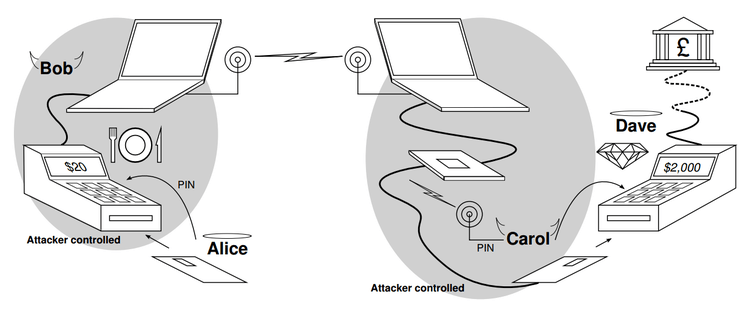Contactless card payments are fast and convenient, but convenience comes at a price: they are vulnerable to fraud. Some of these vulnerabilities are unique to contactless payment cards, and others are shared with the Chip and PIN cards – those that must be plugged into a card reader – upon which they’re based. Both are vulnerable to what’s called a relay attack. The risk for contactless cards, however, is far higher because no PIN number is required to complete the transaction. Consequently, the card payments industry has been working on ways to solve this problem.
The relay attack is also known as the “chess grandmaster attack”, by analogy to the ruse in which someone who doesn’t know how to play chess can beat an expert: the player simultaneously challenges two grandmasters to an online game of chess, and uses the moves chosen by the first grandmaster in the game against the second grandmaster, and vice versa. By relaying the opponents’ moves between the games, the player appears to be a formidable opponent to both grandmasters, and will win (or at least force a draw) in one match.
Similarly, in a relay attack the fraudster’s fake card doesn’t know how to respond properly to the payment terminal because, unlike a genuine card, it doesn’t contain the cryptographic key known only to the card and the bank that verifies the card is genuine. But like the fake chess grandmaster, the fraudster can relay the communication of the genuine card in place of the fake card.
For example, the victim’s card (Alice, in the diagram below) would be in a fake or hacked card payment terminal (Bob) and the criminal would use the fake card (Carol) to attempt a purchase in a genuine terminal (Dave). The bank would challenge the fake card to prove its identity, this challenge is then relayed to the genuine card in the hacked terminal, and the genuine card’s response is relayed back on behalf of the fake card to the bank for verification. The end result is that the terminal used for the real purchase sees the fake card as genuine, and the victim later finds an unexpected and expensive purchase on their statement.

Demonstrating the grandmaster attack
I first demonstrated that this vulnerability was real with my colleague Saar Drimer at Cambridge, showing on television how the attack could work in Britain in 2007 and in the Netherlands in 2009.
In our scenario, the victim put their card in a fake terminal thinking they were buying a coffee when in fact their card details were relayed by a radio link to another shop, where the criminal used a fake card to buy something far more expensive. The fake terminal showed the victim only the price of a cup of coffee, but when the bank statement arrives later the victim has an unpleasant surprise.
At the time, the banking industry agreed that the vulnerability was real, but argued that as it was difficult to carry out in practice it was not a serious risk. It’s true that, to avoid suspicion, the fraudulent purchase must take place within a few tens of seconds of the victim putting their card into the fake terminal. But this restriction only applies to the Chip and PIN contact cards available at the time. The same vulnerability applies to today’s contactless cards, only now the fraudster need only be physically near the victim at the time – contactless cards can communicate at a distance, even while the card is in the victim’s pocket or bag.